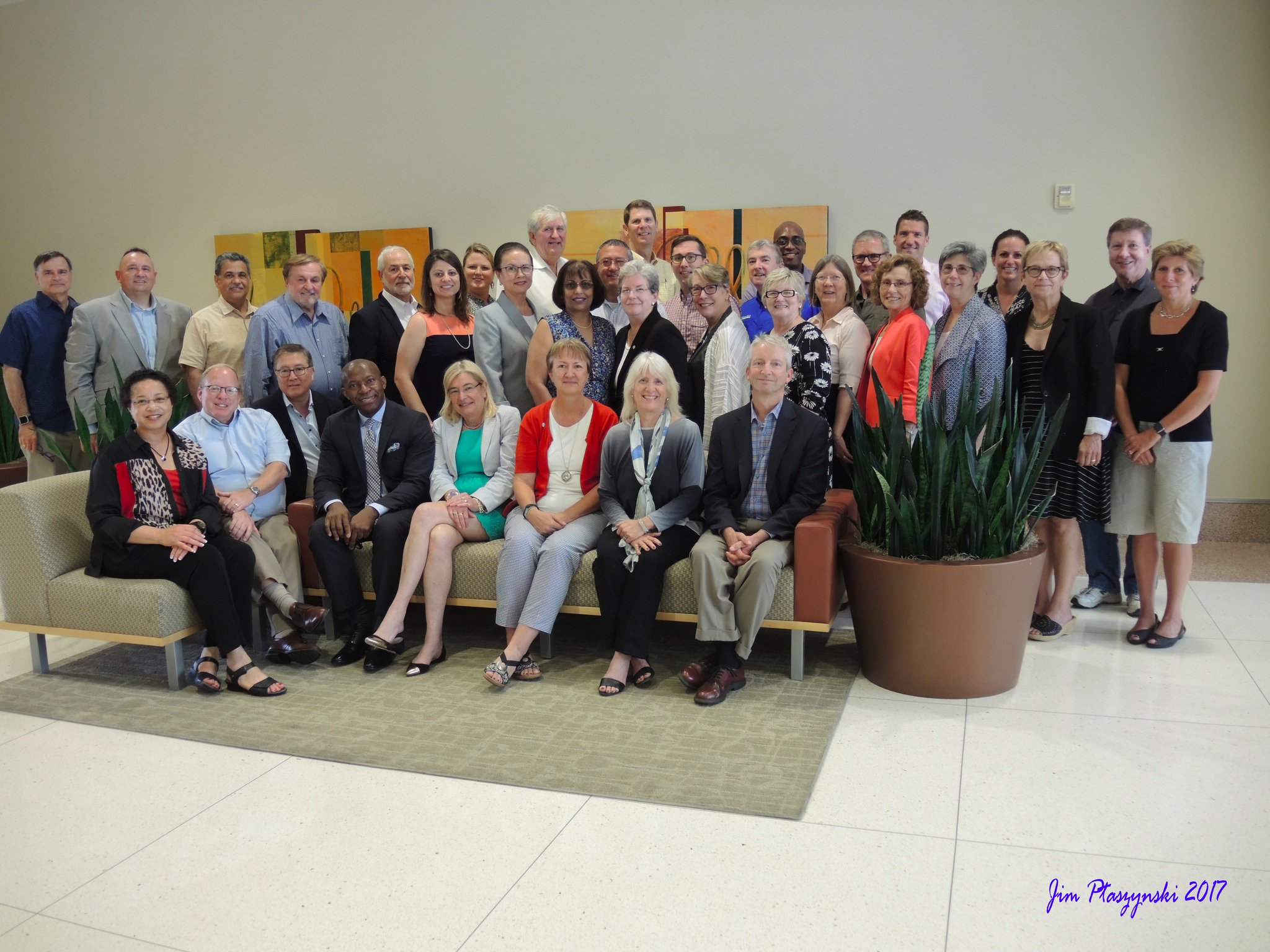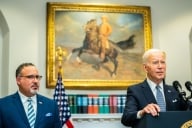You have /5 articles left.
Sign up for a free account or log in.

istock.com/iLexx
When Joe Delap, provost at Athens State University, in Alabama, entered the Association of Chief Academic Officers’ inaugural Digital Fellows Program in January 2017, he wasn’t just hoping to learn how to bring digital learning to his campus. He also wanted to nail down the meaning of the phrase.
“‘Digital learning’ was a new term for me coming into the program,” Delap said. “Now I understand that a focus on … technology and courseware helps not just distance education but face-to-face, too.”
Delap was among provosts from roughly 30 institutions -- ranging widely from nonprofit to for-profit, large to small, public to private -- who spent the past year and a half developing digital learning initiatives on their campuses and convening with colleagues to discuss philosophical issues surrounding classroom technology. According to several participants, the program, made possible by a $1 million grant from the Bill & Melinda Gates Foundation, helped catalyze innovation efforts at campuses across the U.S. and gave many provosts a better understanding of their role in shaping their institution’s digital learning culture.
Conversation Starter
What would you have done in a program like this? Do you think it could help your institution? Comment below.
“If you engage CAOs and provosts, they are likely to be very quick learners,” said Laura Niesen de Abruna, provost at York College of Pennsylvania, who led the program alongside Kenneth C. Green, founder of the Campus Computing Project and a blogger for Inside Higher Ed.
The program operated under the belief that provosts could play an important role in shifting the tide among faculty members toward successfully employing technology in the classroom. Participants convened in person four times, including for a visit to Arizona State University and a session at the 2017 Educause Annual Conference with each provost’s corresponding chief information officer.
Measuring the success of the program in terms of its impact on students is challenging, given the wide range of involved institutions and the scope of their on-campus efforts. According to Niesen de Abruna, the program laid the foundation for adding courseware to 84 courses involving 103 faculty members and 7,500 students. All but two of those courses, according to Niesen de Abruna, saw higher completion rates and lower failure, withdrawal or incomplete rates after the changes were implemented.
Meanwhile, the fellows reported to Niesen de Abruna and Green that the program spurred $8 million of additional investment from their institutions into digital learning initiatives.
"Many of them indicated in lots of different ways that this project happened at their institutions three to five years earlier than they might have otherwise engaged," Green said.
What Participants Took Away
Provosts became increasingly convinced that their most important partner is the faculty -- “getting their attention, getting their involvement, getting them convinced this is a good thing to do,” Niesen de Abruna said. “Once they’re on board, the scaling takes care of itself.”
The program also provided a lesson in the challenges and opportunities that turnover can offer. Three provosts who started the program ended up getting hired as presidents midway through, and a few more stepped down or made lateral moves within their institutions. Despite procedural headaches, these changes helped provosts reflect on the need to establish a culture that outlasts a single campus leader, Niesen de Abruna said.
Provosts said they took lessons from their colleagues that they plan to implement at their own institution. Connie Johnson, chief academic officer and provost at Colorado Technical University, said she admired how some institutions “really celebrated the faculty work in a large way.”
“When you’re working with these tools at scale, you sometimes don’t think about the importance of taking time to really honor the work,” Johnson said.
Delap’s institution purchased a subscription to Adobe Creative Cloud and invested $10,000 in a 3-D scanner that art students can use to digitize their work, share it more widely and critique each other.
“This is a great opportunity for us universitywide to introduce the idea of maker spaces and the maker mentality to students, so when they get out into their careers they have a more entrepreneurial outlook for their artwork,” Delap said.
While a report on student outcomes is still in the works, Delap said student evaluations from the pilot this spring indicate widespread interest in the newly added technology.
Conversations with the other fellows also prompted Delap to redirect a $1 million grant his institution had received from the governor’s office to help improve technology infrastructure. Delap decided the money would be better applied to establishing a center for teaching and learning. “We went from just buying stuff to actually providing professors a space where they can get together,” Delap said.
Margaret Annunziata, vice president of academic affairs at Davidson County Community College in North Carolina, led an effort to tackle physiology courses that had been posting low student performance and completion numbers. Faculty members identified simulation software -- available through the college’s existing subscription to course materials from the publishing company Pearson -- that allowed students to visualize microscopic cell transfers and other processes that aren’t visible to the naked eye or easy to conceptualize.
“In terms of course data that we’ve seen, we did have better retention in the courses. In terms of just looking at individual test scores, we’re not necessarily seeing dramatic increases in that yet.”
 As with efforts at Athens State, students have appreciated the new tools, Annunziata said.
As with efforts at Athens State, students have appreciated the new tools, Annunziata said.
Other experiments haven’t yet been rolled out. At Central State University in Ohio, each new student this fall will receive an iPad loaded with Pearson ebooks they can access before the first day of class. Students will also have the option to enroll in a block of courses taught by an instructor contractually bound to use digital courseware or similar tools. Instructors, meanwhile, will get access to an online tool, created with help from Merlot, that finds open-source equivalents to existing published textbooks.
All of these efforts came from a dawning realization during the program that faculty members need to be trained in more than just how to teach online, and that students need a wide range of tools and options to be successful, according to Pedro Martinez, provost and vice provost for academic affairs at Central State.
“The program itself jump-started the ideas about how we need to integrate digital pedagogy into our teaching,” Martinez said. “It gave an impetus; it just provided us with at least the basic background as to what to do.”
Martinez is one of the provosts who participated in a spinoff convening of CAOs from more than 30 historically black colleges and universities, led by Peter Nwosu at Clark Atlanta University. Martinez thinks that group could lead to a more formal consortium down the road.
What’s Next
In an unusual twist for a program of this nature, the grant money hasn’t run out yet, even as the schedule of events has wrapped up. Close to $130,000 remains, according to Niesen de Abruna.
The Gates Foundation has granted the program a nine-month extension, Niesen de Abruna said. Thus far, the thrust of that extension will be a series of regional workshops that mimic the structure and goals of the original fellowship program. In addition to the Clark Atlanta-led group of HBCUs, such programs have already begun among local cohorts of institutions in Nevada, North Carolina and Texas.
Niesen de Abruna will also represent the Association of Chief Academic Officers on the Gates Foundation’s 13-member Digital Learning Solution Network, led by the WICHE Cooperative for Educational Technologies. That group will work to secure institutional and foundation partners to extend the work of the fellows program.
As the efforts of the initial digital learning fellows spread far and wide, Niesen de Abruna envisions an “institute” format for a future iteration of the program -- a weeklong series of sessions that offers a crash course in the issues hashed out during the fellowship program.
She credits the success of the program in part to her decision to bring together provosts from different kinds of higher ed environments. While some institutions were more successful and involved than others, she admits, even efforts that fell short were instructive.
"There was one institution in which the number of DFWIs did not decrease," Niesen de Abruna said. "The provost was embarrassed, but we think it might take more than one semester for these numbers to move. That CAO is committed to trying again next year."
Several participants told “Inside Digital Learning” they liked that provosts at community college and research institutions were treated the same. Provosts appreciated the rare opportunity to compare notes with others in their position.
“I really do have a network now,” Johnson said.








